Red eyes in dogs can be a cause for concern. As responsible pet owners, it is our duty to ensure the well-being of our furry companions, including dogs eye care for their eye health. Understanding why our dogs’ eyes turn red is crucial in identifying potential underlying conditions and seeking appropriate veterinary care.
This article aims to shed light on the common causes of red eyes in dogs while equipping readers with the knowledge to recognize symptoms and take necessary action. Additionally, it will provide insights into home remedies and care for red eyes, as well as emphasize the significance of overall eye health in dogs.
By delving into this topic comprehensively, dog owners will be empowered to serve their beloved pets better by taking proactive steps towards maintaining optimal eye health.
Key Takeaways
- Red eyes in dogs can be caused by allergies, dryness, glaucoma, and uveitis.
- Prompt veterinary care is necessary when redness or irritation is observed in a dog’s eyes.
- Home remedies such as saline solutions and warm compresses can provide temporary relief for red eyes in dogs.
- Regular check-ups with veterinarians and proper hygiene practices are important for maintaining good eye health in dogs.
Common Causes of Red Eyes in Dogs
Common causes of red eyes in dogs can vary from allergies and dryness to more serious conditions such as glaucoma or uveitis. Recognizing the symptoms is crucial in determining the appropriate course of action for pet owners.
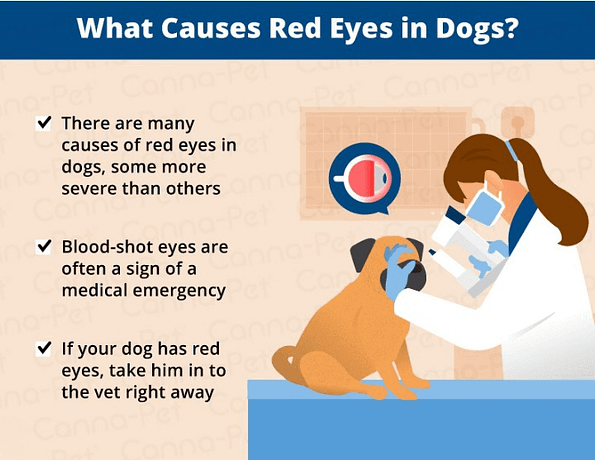
Allergies, for example, may lead to redness, itchiness, and excessive tearing in a dog’s eyes. Dryness can also cause inflammation and redness due to inadequate tear production or an imbalance in tear composition.
In some cases, more severe conditions like glaucoma or uveitis may be responsible for red eyes in dogs. These conditions often present with additional symptoms such as squinting, cloudiness of the cornea, or increased sensitivity to light.
While home remedies such as using saline eye drops or applying warm compresses may provide temporary relief for mild cases, it is essential to consult a veterinarian for proper diagnosis and treatment options to address the underlying cause effectively.
Recognizing Symptoms of Red Eyes in Dogs
Recognizing symptoms of red eyes in dogs can be indicative of an underlying health condition that requires immediate attention. It is crucial for pet owners to be aware of the various signs that may indicate a problem with their dog’s eyes.
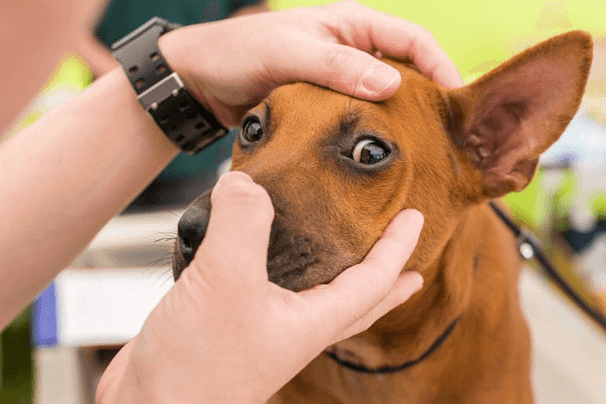
One common symptom is redness or bloodshot appearance in the eyes, which can be caused by a variety of factors such as allergies, infections, or foreign objects in the eye.
Other symptoms to look out for include excessive tearing, squinting, discharge from the eyes, and changes in behavior like increased sensitivity to light or rubbing at the eyes.
If any of these symptoms are observed, it is important to seek veterinary care promptly to determine the cause and provide appropriate treatment. Early intervention can often prevent further complications and ensure optimal care eat pure balance dog food for our beloved pets.
Seeking Veterinary Care
Seeking prompt veterinary care is crucial when observing symptoms of redness or irritation in a dog’s eyes, as it can help to identify and address any underlying health issues that may be causing discomfort.

When it comes to eye problems in dogs, it is best to consult with veterinary eye specialists who have the expertise and equipment to accurately diagnose and treat various ocular conditions. These specialists can perform thorough examinations using specialized tools such as ophthalmoscopes and tonometers to assess the overall eye health and detect any abnormalities.
Depending on the diagnosis, they may recommend specific treatments such as eye drops for dogs, which are formulated to alleviate inflammation or infection.
Additionally, seeking veterinary care ensures timely intervention, preventing further complications and promoting the well-being of our beloved pets.
Home Remedies and Care for Red Eyes in Dogs
To address redness or irritation in a dog’s eyes, it is helpful to explore home remedies and care options that can provide relief and support their ocular health.
Home remedies for red eyes in dogs often involve natural treatments that are safe and gentle. One common remedy is using a saline solution to flush out any irritants or debris that may be causing the redness. This solution can be made by mixing one teaspoon of salt with one cup of distilled water.
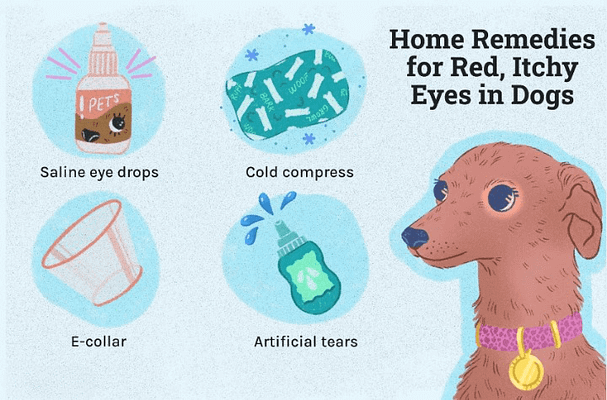
Another option is using chamomile tea bags, which can soothe the eyes when applied as a warm compress.
Additionally, keeping the dog’s eyes clean by gently wiping them with a damp cloth can help alleviate redness and prevent further irritation.
It is important to note that while these home remedies can provide temporary relief, it is always recommended to seek veterinary advice if the problem persists or worsens.
Treating Underlying Conditions
Treating underlying conditions is crucial in addressing the root cause of ocular issues and ensuring long-term relief for our canine companions. When it comes to red eyes, there are a few common underlying conditions that may be causing the problem.
Treating allergies is one important step in managing red eyes. Allergies can irritate the eyes and cause them to become red and itchy. Identifying and avoiding allergens, such as pollen or certain foods, can help alleviate symptoms.
Another common condition associated with red eyes is dry eyes. This occurs when there is insufficient tear production or poor tear quality, leading to eye irritation and inflammation. Treating dry eyes typically involves using artificial tears or medications that stimulate tear production.
In order to effectively treat red eyes in dogs, it is important to identify and manage any underlying conditions such as allergies or dry eyes. By doing so, we can provide our furry friends with the relief they need while promoting their overall well-being.
Preventing Red Eyes in Dogs
To effectively prevent red eyes in dogs, it is crucial to address underlying conditions and implement preventative measures. By treating any existing issues such as allergies or infections, the likelihood of red eyes can be significantly reduced. Additionally, taking steps to prevent dry eyes and common eye infections is essential. This can include regular cleaning of the dog’s eyes with a gentle saline solution and keeping their environment clean to minimize exposure to irritants.
It is also important to avoid using harsh chemicals or products near the dog’s face that may cause irritation. Furthermore, maintaining proper hygiene by regularly trimming hair around the dog’s eyes can help prevent debris from accumulating and causing inflammation. By implementing these preventive strategies, dog owners can play an active role in reducing the occurrence of red eyes in their pets.
| Preventative Measures | ||
|---|---|---|
| Treating underlying conditions | Regular cleaning with saline solution | Avoiding harsh chemicals |
| Maintaining proper hygiene | Keeping environment clean | minimizing exposure to irritants |
Taking Care of Your Dog’s Eye Health
Maintaining proper eye health for your dog is crucial in ensuring their overall well-being. Just like humans, dogs can also suffer from various eye conditions such as allergies and infections.
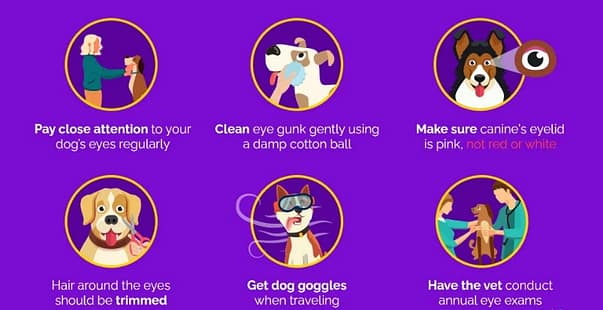
Dog eye allergies are often caused by environmental factors such as pollen, dust, or certain chemicals. These allergens can cause redness, itching, swelling, and excessive tearing in the eyes. It is important to identify and eliminate the source of the allergy to provide relief for your furry friend.
On the other hand, dog eye infections are usually caused by bacteria or viruses that enter the eyes through foreign objects or unclean environments. Symptoms may include redness, discharge, squinting, and even vision loss if left untreated.
Regularly cleaning your dog’s eyes with a veterinarian-recommended solution and ensuring they have a clean living environment can help prevent both allergies and infections.
Understanding the Importance of Eye Health in Dogs
Ensuring optimal eye health in dogs is essential for their overall well-being and should be prioritized to prevent potential complications. Regular check-ups play a crucial role in maintaining good eye health in dogs. These appointments allow veterinarians to detect any early signs of common eye problems such as conjunctivitis, cataracts, or glaucoma. Early detection can lead to prompt treatment and better outcomes for the dog’s vision.
Additionally, regular check-ups provide an opportunity for professionals to educate pet owners on proper eye care techniques and preventative measures. Common eye problems in dogs can cause discomfort and affect their quality of life if left untreated. By addressing these issues promptly through regular check-ups, dog owners can ensure that their pets live happy and healthy lives with clear vision.
Red Eyes in Dogs as a Symptom of Serious Health Conditions
Red eyes can be a symptom of serious health conditions in dogs, such as canine distemper, corneal ulcers or injuries, glaucoma and other eye diseases, as well as systemic diseases affecting the eyes.
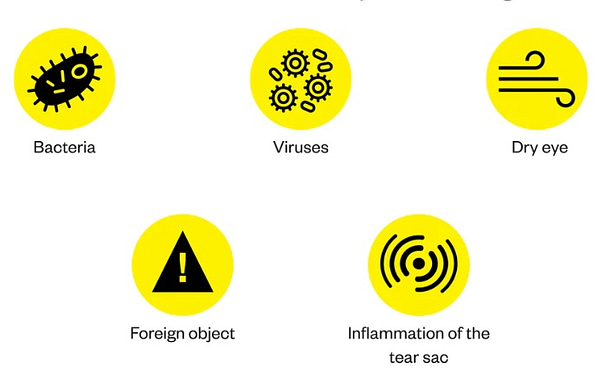
Canine distemper is a highly contagious viral disease that affects multiple organ systems, including the eyes.
Corneal ulcers or injuries can cause redness and inflammation in the eyes, leading to discomfort and potential vision loss.
Glaucoma and other eye diseases can also result in red eyes due to increased pressure within the eye or damage to the optic nerve.
Additionally, certain systemic diseases such as autoimmune disorders or infections can affect the eyes and cause redness as a symptom.
Canine distemper
Canine distemper is a highly contagious viral disease that can cause redness and inflammation in a dog’s eyes. It is important to recognize the symptoms of canine distemper early on, as prompt treatment can improve the chances of recovery.
When it comes to treating red eyes caused by canine distemper, there are several options available. These include:
- Antiviral medications: These medications can help control the spread of the virus and reduce inflammation in the eyes.
- Eye drops or ointments: These can provide relief from redness and irritation.
- Supportive care: This may involve providing fluids, nutrition, and supportive medications to keep the dog comfortable during their recovery.
It is crucial to consult with a veterinarian for an accurate diagnosis and appropriate treatment plan for dogs with red eyes due to canine distemper.
Corneal ulcers or injuries
Corneal ulcers or injuries can also cause redness in a dog’s eyes. Corneal abrasions, which are superficial scratches on the surface of the cornea, can occur due to trauma or irritants such as dust or dirt. These injuries can result in red and irritated eyes, along with other symptoms like excessive tearing, squinting, and sensitivity to light.
Additionally, a foreign body like a small piece of debris or an eyelash stuck in the eye can lead to corneal irritation and redness. It is essential to address these issues promptly as untreated corneal ulcers or injuries can worsen and potentially lead to more severe complications such as infections or even vision loss.
If you notice any signs of corneal ulcers or suspect a foreign body in your dog’s eye, it is advisable to seek veterinary attention for proper diagnosis and treatment.
Glaucoma and other eye diseases
Glaucoma, a condition characterized by increased intraocular pressure, can lead to vision loss in dogs if left untreated. It is essential to recognize the signs of glaucoma early on and seek prompt veterinary care.
Treatment options for glaucoma in dogs include medication to reduce intraocular pressure, surgical procedures like laser therapy or drainage implants, and occasionally removing the affected eye if it becomes unmanageable.
Additionally, it is crucial to prevent common eye infections that can contribute to the development of glaucoma. Regularly cleaning your dog’s eyes and keeping them free from debris can help maintain their ocular health.
Moreover, seeking regular check-ups with a veterinarian can aid in detecting any potential eye diseases before they progress into more severe conditions like glaucoma.
Systemic diseases affecting the eyes
Moving on from discussing glaucoma and other eye diseases, we will now delve into the topic of systemic diseases affecting the eyes in dogs. It is important to recognize that dogs, like humans, can suffer from various health conditions that may manifest in their eyes.
One common issue is canine eye allergies, which can cause redness and inflammation in the eyes. Allergens such as pollen or dust mites can trigger an allergic reaction in susceptible dogs, leading to symptoms like itching and watery discharge.
Additionally, conjunctivitis in dogs is another systemic disease that affects the eyes. Conjunctivitis refers to inflammation of the conjunctiva, a thin membrane covering the front part of the eye and lining the inner surface of the eyelids. This condition can be caused by infections, irritants, or underlying health issues such as allergies or autoimmune disorders.
Understanding these systemic diseases is crucial for identifying and treating any underlying causes contributing to your dog’s red eyes.
See Also:
- Dog Teeth: Ensuring Optimal Dental Health for Your Canine Companion
- How To Tell If Dog Has Fever
- Why are Dog Nose Wet
- How To Potty Train A Dog
- How Often Do Dogs Need Rabies Shots
- Cool Tool Shows How The World Looks To Dogs
Conclusion
In order to ensure the overall well-being of your furry companion, it is essential to take proactive measures to address any potential issues with their eye health.
Taking action for your dog’s eye health involves being observant and vigilant. Regularly inspecting your dog’s eyes for any signs of redness, discharge, or inflammation can help identify any underlying problems early on. If you notice these symptoms persistently or if they worsen over time, it is important to consult a veterinarian for a proper diagnosis and treatment plan.
Additionally, practicing good hygiene by keeping your dog’s eyes clean and free from debris can prevent infections and other eye-related issues. Remember that prevention is key when it comes to maintaining optimal eye health in dogs, so taking the necessary steps to protect their vision should be a priority for every pet owner.
“If you can’t find the right dog for you to adopt locally, please consider adopting a dog from Bone Voyage Dog Rescue. We’ll fly with your dog to you.”
Frequently Asked Questions
Can I use over-the-counter eye drops to treat my dog’s red eyes?
Using over-the-counter eye drops on dogs can have potential side effects. Natural remedies, such as using saline solution or chamomile tea, are safer options for treating red eyes in dogs. Serving others includes prioritizing their well-being by choosing the best and safest solutions for their health.
How long does it usually take for red eyes in dogs to clear up?
The duration of red eyes in dogs can vary depending on the underlying cause. Home remedies such as gentle cleaning, saline solution, and avoiding irritants may help alleviate symptoms and speed up recovery.
Are there any specific breeds that are more prone to red eyes?
Certain dog breeds are more prone to red eyes, including Cocker Spaniels and Bulldogs. Treatment options for red eyes in dogs depend on the underlying cause and may include medication, eye drops, or other interventions prescribed by a veterinarian.
Can allergies cause red eyes in dogs?
Allergies in dogs can cause red eyes, known as allergic conjunctivitis. This condition can lead to dry eyes and discomfort for the dog. Treatment options include antihistamines, eye drops, and identifying and avoiding allergens.
What are some common signs that my dog’s red eyes may be a symptom of a serious health condition?
Common signs that red eyes in dogs may be a symptom of a serious health condition include discharge, excessive tearing, squinting, pawing at the eyes, cloudiness or opacity in the eye, and changes in behavior. Dog eye infections and other common eye problems in dogs should be considered as potential causes.
